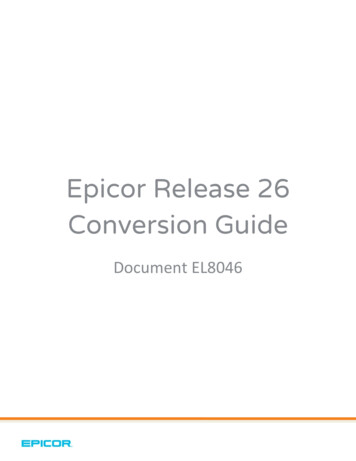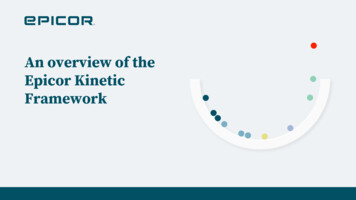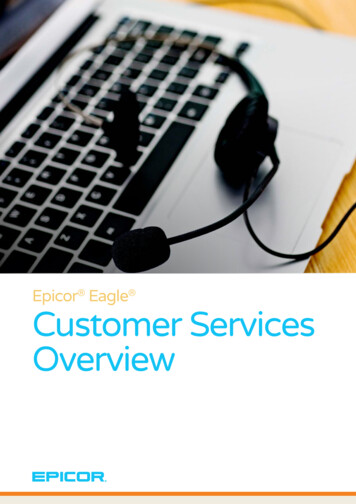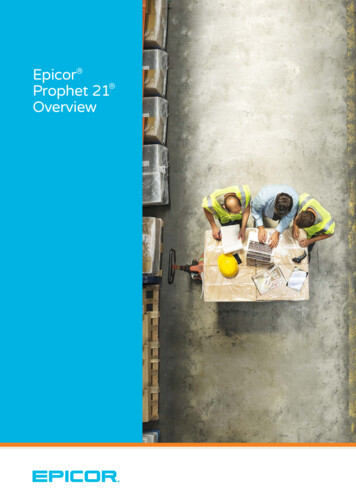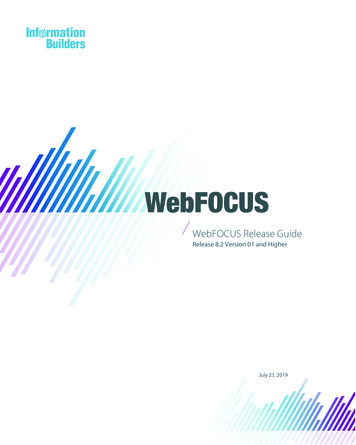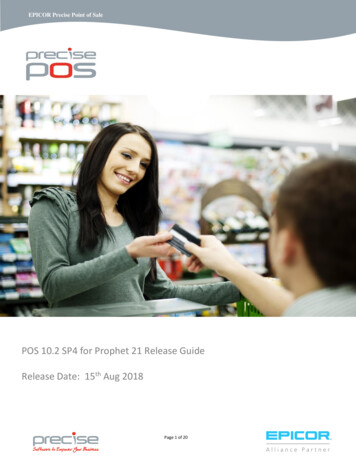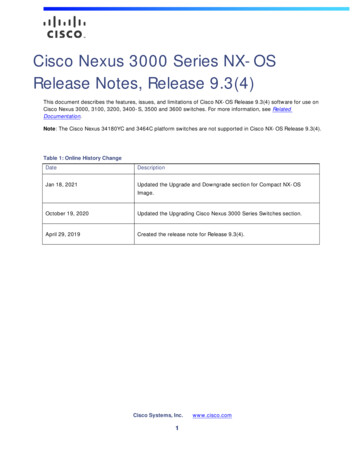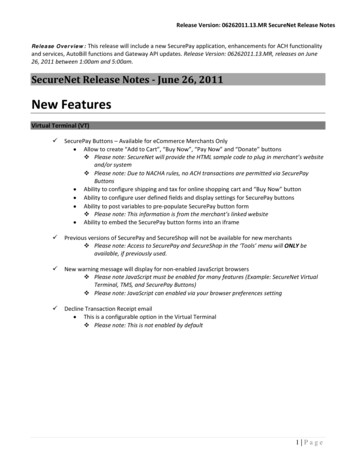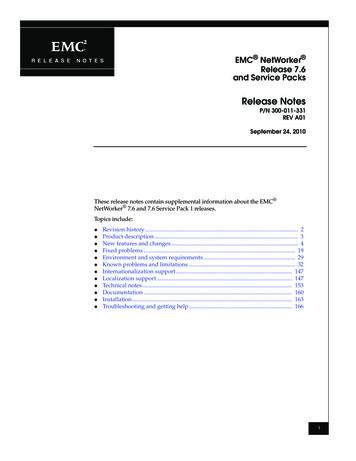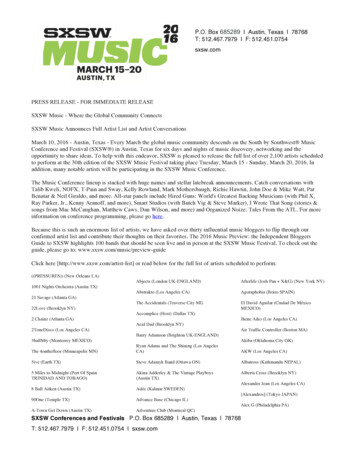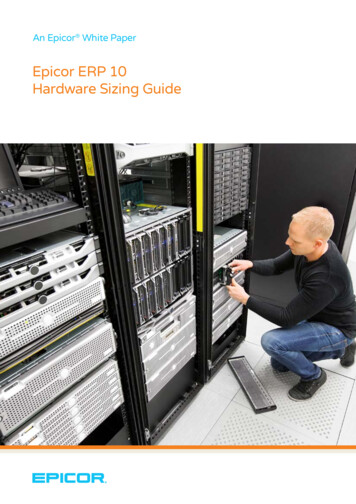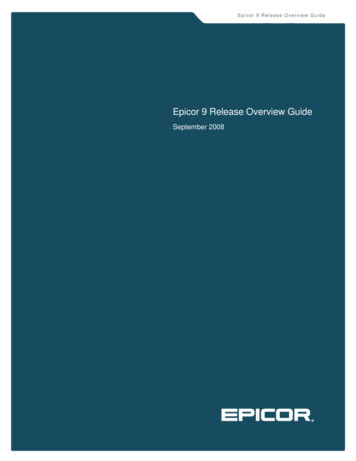
Transcription
Epicor 9 Release Overview GuideEpicor 9 Release Overview GuideSeptember 2008
Epicor 9 Release Overview GuideDisclaimerThis document contains an overview of the planned capabilities of Epicor 9. It isintended for anyone wanting a general understanding of Epicor 9. This documentincludes descriptions of product functionality that is not presently available. Thisdocument is intended to communicate Epicor Software Corporation’s currentintentions and is accurate as of September 2008. However, Epicor reserves theright to make modifications or changes to the functionality, release dates,technology, initiatives and plans described herein as business conditions dictateand without further notice. This document is not intended to obligate Epicor or anyother entity to such functionality, release dates, technology, initiatives and plans,but merely to inform the audience of Epicor’s current intentions. This document isfor informational purposes only and is subject to change without notice. Epicormakes no warranties, express or implied in this document. The contents of thisdocument are believed to be current and accurate as of its date of publication. Fora complete description of the product features, please refer to the product’s userguides, reference manuals and release notes. Companies, names and/or dataused in screens, if any, are fictitious, unless otherwise noted.This document also includes many “forward-looking statements” regardinganticipated product functionality, targeted release dates, availability of technologyand certain company initiatives that involve risks and uncertainties, and actualresults may differ materially. Such forward-looking statements, which are nothistorical fact, involve risks and uncertainties and actual results might differmaterially. Such risks and uncertainties include but are not limited to, thecompany’s ability to rapidly develop and introduce new products, reliance on thirdparty products; reliance on emerging technologies and markets; the timelyavailability and market acceptance of new products and upgrades, the impact ofcompetitive products and pricing, and the discovery of undetected software errorsand other factors discussed in the Company’s Annual and Quarterly reports,including on Form 10-Q for the period ending June 30, 2008. As a result of thesefactors, the business or prospects expected by the company as part of this papermay not occur. The company undertakes no obligation to revise or update publiclyany forward-looking statements.September 2008i
Epicor 9 Release Overview GuideTable of ContentsExecutive Summary1Global Support2Global Engines2Global Capabilities3Global Multisite Management3Financial Management5General Ledger5Accounts Receivable7Accounts Payable10Cash Management10Currency Management11Asset Management12Multiple Books12Rebate Management13Customer Relationship Management14Epicor Information Worker15Marketing Management15Contact Management16Lead and Opportunity Management17Case Management17Sales ManagementEstimate and Quote Management19Order Management19Demand Management23Storefront24Electronic Data Interchange24Production Management25Job Management25Lean Production26Manufacturing Execution System (MES)27Quality Assurance27Advanced Quality Management28Supply Chain ManagementSeptember 20081929Inventory Management29Advanced Material Management31ii
Epicor 9 Release Overview GuideShipping & Receiving33Purchase Management35Purchase Contracts36Supplier Relationship Management36Planning and SchedulingProject Management38Forecasting, Scheduling and Resource Management39Material Requirements Planning42Product Data Management44Bill of Materials44Engineering Change and Revision Control44Routings45Product Costing45Product Lifecycle Management46Product Configuration46Service Management48Return Material Authorization48Field Service48Contract Management49Human Capital Management50Payroll50Human Resource Management51Training and Recruitment52Employee Self-Service53Epicor Enterprise Performance Management54Management Reporter54Operational Data Store and Data Warehousing54Epicor Replication Server55Scorecards and KPIs55Budgeting, Planning and Forecasting56Business Activity Query Designer56Business Activity Query Report Designer57Dashboards and Trackers57Tools and TechnologySeptember 20083860Epicor ICE 2.0 Business Architecture60Personalization61Styling and Themes62Epicor Portal62Web 2.063Support for Software as a Service63iii
Epicor 9 Release Overview GuideSeptember 2008Searches64Business Activity Management64Business Process Management65Epicor Service Connect66Epicor Advanced Print Management67Customization68Globalization and Localization69System Management69Software Development Kit71Epicor Documentation and Content Delivery72About Epicor74iv
Epicor 9 Release Overview GuideExecutive SummaryEpicor 9 is the result of more than 20 years of experience delivering high value,low total cost of ownership (TCO) ERP solutions to the global midmarket and thedivisions and subsidiaries of large enterprises. Epicor’s extensive experience inbuilding solutions for the accounting, distribution, manufacturing, and servicessectors all comes together in Epicor 9. It is the culmination of the CONVERGE1pillar of our PROTECT, EXTEND, CONVERGE product strategy , combiningtechnology and functionality from all our award-winning ERP solutions into asingle next-generation enterprise application solution to deliver even morebusiness value for our customers.Epicor 9 is built using Epicor ICE 2.0 business architecture, which incorporatesEpicor True SOA , a unique service-oriented architecture (SOA) that providesunprecedented choice and flexibility in how business solutions are deployed andused by all stakeholders inside and outside of a business.The purpose of this document is to provide you with a comprehensive introductionto the complete Epicor 9 release allowing you to better understand how thisgroundbreaking solution can be used to add value to your business, improveenterprise performance and control over your operations, and enable yourorganization to more easily achieve strategic and tactical business goals.1Please refer to Protect. Extend. Converge. Epicor Strategy Briefing, April 2007.September 20081
Epicor 9 Release Overview GuideGlobal SupportGlobal EnginesIn support of the global nature of business, Epicor 9 provides a number of featuresthat will allow users to support operations in existing and new markets. The ideabehind several of the “engines” delivered in the base application is to provide theability for “out-of-the-box,” country-specific support. These global features includethe Global Posting Engine, Global Tax Engine, Legal Numbering, and theRounding Engine. For example, these global engines within the application are allconfigurable to meet the local legal, fiscal, country best practices, or customerspecific needs.Global Posting Engine: The rules-based Posting Engine is central to the Epicorfinancial applications which will allow for companies to use either: An “out-of-the-box” set of posting rules and business transactions, or Customizable sub-ledger posting rules (this would define how transactionsfrom the sub-ledgers can be posted to the general ledger (for example,the same transaction can be posted to two different accounts in twodifferent books).Global Tax Engine: Due to the diverse, international requirements for countryspecific tax requirements, a Global Tax Engine is leveraged to allow the system tobe configured to country specific requirements to support the tax regime for salestax, VAT, use tax, etc.Legal Numbering Engine: Due to the country-specific international legalnumbering requirements of Epicor customers, a legal numbering engine wasadded as a part of the application to manage legal numbering of the printedtransactions that the company sends to a customer or supplier. Specifictransactions that the legal numbering engine affects are: Sales Orders Purchase Orders Promissory Notes AR Invoices Credit Memos Payments (checks)Rounding Engine: The Rounding Engine allows for the definition of currencyrounding rules that can be selected for use within each of the associated modules.The rounding engine is configurable by customer, country, currency, and businesspractice. Number of decimals to use for amounts shall be specified per currency.Everywhere in the system where amounts are calculated, rounding is calculated tothe number of decimals defined for the currency of the value. For example, whencreating sales documents, amounts shall be calculated and rounded according tothe defined rules for the currency of the document (the actual value printed on thedocument is always rounded to the number of decimals in the currency).September 20082
Epicor 9 Release Overview GuideGlobal CapabilitiesEqually as important as the global engines to our customers are the globalcapabilities of the application primarily in the areas of Multicurrency, Multicompanyand Multilingual capabilities.Multicurrency: Multicurrency focus on exchange rate effective dates, multiplerate types, currency overrides at the transactional level including exchange rate atpayment entry, revaluation enhancements, and reporting currencies which can beused in conjunction with Multiple Books.Multicompany: Multicompany functionality provides for multiple companies withinthe same database as well as intercompany trade and transactions, which is theability to work in multiple companies from a single sign-on. Based on a user’ssecurity settings, a user will be able to centrally process sales orders and createtransactions and journals from within the same session without having toconstantly switch companies. Users will be able to see from the menu all thecompanies to which they have access for transaction purposes.Language Support: A single instance of the Epicor 9 software can supportmultiple languages with each available language displayed based on a user’spreference.Global Multisite ManagementUse the Multisite Management module to synchronize distribution of goodsacross multiple sites and the synchronization of master data across sites. Thissingle system provides visibility and consolidation of resources in multiplefacilities. It also supports running business functions centralized with separateproduction or distribution functions, or running them separately with the ability toconsolidate financials at month or quarter-end. Multisite Management providessupport for centralized accounting and purchasing, while allowing separation ofproduction or distribution facilities.Alternate Bill of Materials per Plant: Define alternate BOMs per part, per plant.When the same part is produced at multiple facilities, each plant can generate aBOM inclusive of their processes and configuration.Alternate Routings per Plant: Define alternate routings per part, per plant. Whenthe same part is produced at multiple facilities, each plant can execute a routinginclusive of their processes and configuration. You retain visibility and control, asplant-specific routings are maintained as sub-revisions of the base revision.Cost by Plant: Hold average, actual, and last costs per part, per plant, ensuringthe same costs apply to all plants.Credit Checking: Define each company with its own credit limit against acustomer, or you can deploy a global credit limit consumed by all of a customer'ssales across all your companies.Deployment: Deploy your companies on a single server/single database, or onmultiple databases and multiple servers around the world. Many enterprisesrequire their companies' data management systems to be geographicallydispersed on different servers and different databases, to protect againstcommunication glitches causing site downtime.Financial Consolidation: Set up multicompany consolidation between anycompanies within the Epicor database. Financial rollups can even be done withcompanies outside Epicor.Forecasts: Automatically send raw material forecasts to the supplycompanies. Later, these forecasts can be firmed up by creatinginter-company purchase orders.September 20083
Epicor 9 Release Overview GuideGlobal Customers, Parts and Suppliers: Define global customers, parts andsuppliers. Global customers, suppliers, and parts can now have recordstransferred and maintained between companies. Based on a set of user-definedrules and mappings, automatically ensure that new and changed records are sentto all companies within your enterprise.Global Supplier Price Agreements: Send agreements to all companies bysetting up global price agreements for key raw materials to ensure materials arepurchased from the correct supplier at the appropriate global price.Intercompany Eliminations: Map accounts between companies for smooth intercompany eliminations. With frequent mergers and acquisitions, the general ledgeraccount structure between parent and child companies may not be the same.Intercompany Trading: Streamline inter-company transactions with MultisiteManagement. Multisite enables your companies to trade with each other viaautomatic sales and purchase orders; share forecasts; buy from global supplierprice agreements; and identifies enterprise-wide credit limits for customers. Intercompany purchase order and sales order links have been established. Salesorders can be automatically generated from purchase orders made by companieswithin your enterprise. Additionally, all changes from the purchasing company areimmediately visible to the selling company, and any changes made by the sellingcompany are automatically sent to the supplying company.Master Data Management (MDM): Collect, aggregate, match, consolidate, andpersist distributed data throughout the organization to ensure consistency andcontrol in the ongoing maintenance and application of master data information.Multicompany: Provide for multiple companies to be managed in a singledatabase, multiple databases, or a combination of both. You dictate whether tohold all companies in a single database, or each company in individual databases,where each company can have its own chart(s), base currency, and calendars.Multiple Currencies: Consolidate financials in any currency. Each company inthe hierarchy has its own currency, and the top-level corporation may have adifferent currency not shared with any other company.Plant Scheduling Functions: View jobs for one plant or all plants, depending onsecurity. This provides control and flexibility to each production facility, which oftenhas its own production planner and scheduler.Production Plants: Gain visibility to separate each plant's resource groups,inventory levels and jobs.Shared Warehouses: Share one or more warehouses per plant to reflect the wayeach company conducts its business.Sourcing by Plant: Define a unique source per part or plant - whether its defaultsourcing is purchased, produced or transferred. What is produced in one locationmay be purchased - or transferred in - from another.Subcomponent Security: Authorize each user to view only information aboutspecific companies to which they have access.Unique Accounts: Establish individual accounts, including inter-companyelimination accounts, for each plant and company.Unlimited Hierarchy: Define the parent-child relationships between companies inan unlimited hierarchy. Each organization can have a parent company, which mayalso have another parent company, and so on.Virtual Plant Support: Divide single sites with multiple production lines intomultiple sites for virtual plants.Virtual View: Build virtual views of the enterprise. For example build a workbenchthat allows a user to see all orders for a customer across all companies eventhough those companies may exist on separate servers and databases. The usercan then open sales orders in separate companies all from the same workbench.September 20084
Epicor 9 Release Overview GuideFinancial ManagementEpicor 9 financial management solutions provide you with the tools needed tocreate value through monitoring financial conditions and timely decision making.General Ledger, Accounts Receivable, Accounts Payable, Cash Management,Currency Management, Asset Management, and Payroll help you monitor andmanage invoicing, payments, assets, and payroll and benefits to reduce costs andimprove cash flow. Epicor 9 financials can help improve your ability to drop moreto your bottom line, the ultimate test of your success and competitive advantage.General LedgerGeneral Ledger (GL) processes and posts entries created by the operationalareas of Epicor 9, as well as manual entries made directly in GL. A chart ofaccounts is easily established to control how you want the system to report onyour business.Account Tracker: Show the current activity and balances for the period youspecify. Locate an account through word search capabilities. Summarize view withoptions to drill down to account detail and supporting journal entries.Adjustments: With proper security, make prior year adjustments, and allbalances forward will be adjusted.Allocations: Automate allocation of funds across multiple accounts withoutmanual entry.Auto-Export: An open database design allows easy export of general ledger datato third-party software packages for additional graphing and reporting analysis.Balance Controls: Balance Controls allow the user to define the frequency atwhich balances on GL accounts are captured and stored. This flexibility allows theuser to update account balances as frequently as required: by minute, by hour, byday, by week or by month. The key benefit of this flexibility affects the timelinessand accuracy of financial reporting. When running reports across periods orbetween periods or even within the same day the system will be able to moreeasily access the data and retrieve the required information for the user. This willimprove not only the performance of the system but also the speed with which abusiness can digest and react to that information.Budgets: Enter figures for any account and year. Globally update budgetsby percentage.Chart of Accounts: Epicor 9 allows for up to 20 user-definable segmentswithin the Chart of Accounts (COA) that can be used for accounting or referencepurposes providing the ability to record, store allocate and report on importantfinancial data at a highly granular level. For example, you will have the ability toset up accounting segments to cover the natural account, divisions, cost centers,plant and warehouse, if so desired. The remaining 15 segments could then beused as reference code segments used to track specific non-accountingdata against general ledger accounts in the same book or in a completelyseparate book.The total number of characters available to be used in the creation of thesegments within the COA is 200. That’s just for the segment values (includingseparators); separate description fields allow for longer textual descriptions.As part of the definition of the Chart of Accounts we allow the users to define if asegment is balance segment, i.e. will allow the creation of a P & L and potentiallya Balance Sheet for that segment, or if it is just a reference code dimension.Should a user choose to create a balanced segment this, provided the set up iscorrect in the General Ledger, will allow a user to create for example a P & L bySeptember 20085
Epicor 9 Release Overview Guideproduct line, or customer account, or even cost center. Where a user of thesystem uses a segment as a “dimension” this would allow for the tracking of costsbooked for example against specific Trade Fair within a Trade Shows GL account.This flexibility affords the user considerable scope to track and report on theirbusiness operations. There is also the ability to copy a Chart of Accounts.Consolidations: The consolidation functionality meets the needs of businessestoday with consolidation at either a summary or detailed transaction level fromdifferent books and or companies within a defined relationship. This process alsoprovides an “intermediate
Epicor 9 is the result of more than 20 years of experience delivering high value, low total cost of ownership (TCO) ERP solutions to the global midmarket and the . from the sub-ledgers can be posted to the gen
